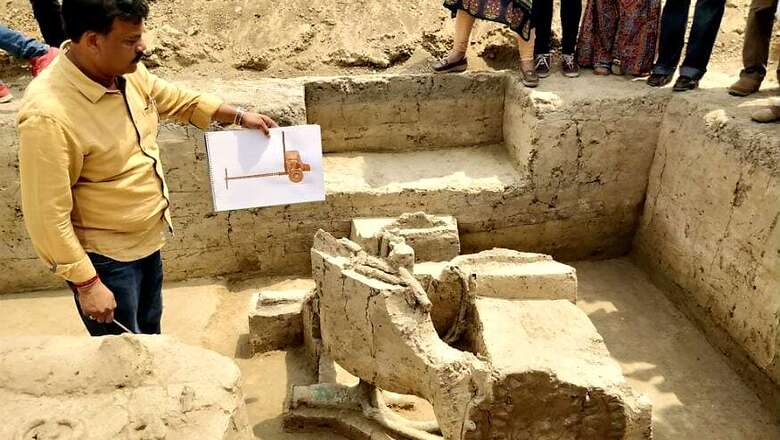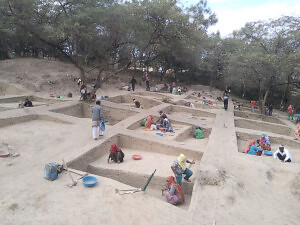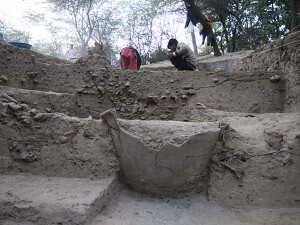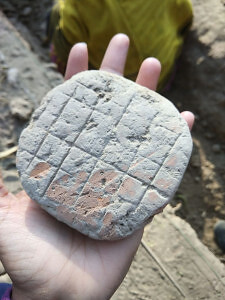Dating Mahabharata to 2000 BC: Archaeologists Shift from Painted Grey-Ware to Ochre Coloured Pottery

views
New Delhi: From the archaeological remains at Hastinapur and Sanauli, and from archaeologists BB Lal and SK Manjul, the aim to ascertain the exact date of Mahabharata remains the same. But in that pursuit the cultural relations of archaeology have changed, thereby opening the possibilities for exploring the dates of Mahabharata somewhere between 1100 BC and 2000 BC.
Spate of excavations in Uttar Pradesh’s Sanauli and Chandayana have thrown open possibilities of new cultures for the current archaeologists and they differ from Lal’s hypothesis. Lal correlated the ‘Painted Grey Ware Culture’ of archaeology to Mahabharata and bracketed it in the 1100 BC time frame. The new hypothesis now strikes the correlation between Ochre Coloured Pottery (OCP) with the Mahabharata Culture, which brackets it in 2000 BC.

Based on the excavations conducted under him in Sanauli, where a chariot was found in June, SK Manjul, the director of Institute of Archaeology, under Archaeological Survey of India, delivered a lecture in July 2018 in Delhi. The title of the talk was “Mahabharata and Archaeology: PGW vis a vis OCP/Copper Hoard Culture.”
In the lecture, Manjul made a case for OCP as a culture relation to Mahabharata. The presentation was: “The hypothesis given by BB Lal and others on the basis of archaeological findings in the lower strata at Hastinapur and similar findings from other sites mentioned in the Mahabharata correlated Painted Grey Ware Culture with the Mahabharata Era.” Lal noticed Painted Grey Ware from important sites mentioned in Mahabharata and time bracket of war suggested around 1000-900 BCE. But recent excavations in Sanauli, Barnawa and Chandayana have a different story to tell - that of much earlier culture OCP.
Archaeology of Mahabharata: Then and Now
The early hypothesis in post independent India suggested time 1000 BCE with cultural relation of PGW. And the New Hypothesis suggested time 2000 BCE with Cultural relation: OCP/ Copper Hoard, according to Manjul.

As per the archaeologists, who are votaries of the New Hypothesis, PGW is marked with “rural settlements, pit dwellings and hut. There are weapons, arrow, head small, spear head, agriculture tools, bone points, metal iron. No chariots found. It shows limited and distinct pottery traditions. It has very less information on Vedic rituals and traditions.”
On the other hand, the archaeologists say that the OCP is marked with “Advanced weapons and tools, antenna sword Harapoon celts, dagger and shield, metal copper and advance chariot found. Advance pottery tradition including metal pots. Also, it has similarity with Vedic rituals.”
Hastinapur is mentioned in Mahabharata while Sanauli is not.
But for the New Hypothesis, Sanauli became significant because of its findings - a chariot was excavated from the royal burial pits in June 2018. “The Mahabharat clearly belongs to a heroic age, mentions the use of many weapons extensive use of chariots as war vehicles contact and relations with other territories sophisticated lifestyle and Vedic beliefs. The evidence found from Sanauli shows similar cultural affinities as narrated in the Mahabhrata,” Manjul said.
Sanauli is OCP site of Ganga Jamuna Doab and its tributaries were the core zone of OCP/Copper Hoard Culture, contemporary to Harappan civilisation.

Manjul and his team, which also includes his partner Arvin Manjul, the co-director at Sanauli excavations, also conducted excavations in Barnawa to find the House of Lacs but it showed no evidence to support the myth but is PGW site. “We need collective excavations for understanding the complete cultural scenario, review the date of society mentioned in Mahabharata related to PGW or OCP Copper Hoard,” he said.
News 18 contacted BB Lal who propounded the correlation between the PGW and Mahabharata. He is not convinced with the New Hypothesis because Sanauli is not the site mentioned in the text, “There is no evidence to link it to Mahabharata culture, these sites are not mentioned in the texts,” he said.
The Critics of Correlation of Archaeological trends with Mahabharata
Lal’s “Excavation at Hastinapur and Other Explorations” was the first systematic description of the Culture. Irfan Habib, the Marxist historian, had written in article “Unreason and Archaeology: The Painted Grey Ware and Beyond” questioning archaeologist BB Lal’s report, which “owed its popularity in part to his attempt to find the PGW a proof of the historicity of the sacred epic literature.” The above mentioned article appeared in journal Social Scientists.
Habib wrote that Lal knew of the dates calculated for Mahabharata.
Different dates of Mahabharata have been given by different historians. There was 3,102 BC calculated by PC Sengupta, 1424 BC by KP Jayaswal, 1400 BC by AS Altekar, 1152 BC by SN Pradhan, and 9th century BC by HC Raychaudhuri. But Lal picked up 950 BC given by FE Pargiter.
“So he could rhetorically ask: Is it a mere chance that the date of the Mahabharata falls within Period II of Hastinapur?” (Period II being that of Painted Grey Ware).
According to Habib “Lal gave very high time values to the accumulation of deposits below the Northern Black Polished Ware levels, which themselves could not be dated beyond 600 BC.” There have been other critics of correlation between PGW and Mahabharata, for instance DH Gordon in his book “The Prehistoric Background of Indian Culture” doubted Lal’s estimates by saying, “The presence of PGW could not be put beyond 650 BC.”
Mortimer Wheeler in “Early India and Pakistan to Ashoka” stated that deposit of PGW at Hastinapur could not be made to carry the beginning of the ware to beyond 800 BC.
On the correlation between archaeology and Mahabharata, Meera Visvanathan, Assistant Professor Department of History School of Humanities and Social Sciences at Shiv Nadar University spoke to News 18. She said, “The sites mentioned in Mahabharata fall into the region of Indo-Gangetic divide, where Indo-Aryans moved into India and set up their first settlement – Kurukshetra. Mahabharata is tied up with this process.”
BB Lal associates archaeological culture relations at various sites with the Mahabharata, but “Mahabharata as a story is far grander. The process of storytelling took its own time. What we have today is not a contemporary chronicle to that original event. It is more a product of poetic imagination. These correlations between the text and archaeology have been common but not much has been derived from it.”
The dating of the Mahabharata War has often been challenging and controversial. Manjul said, "European scholars have maintained that the events described in ancient Sanskrit texts are imaginary. Subsequently, the Mahabharata has been derived to be a fictitious tale of war fought between two rivals – the Pandavasand the Kauravas. The heart of the story is very ancient.”
He added, “On the contrary, many Indian scholars have vehemently maintained the actual occurrence of the Mahabharata War. On the basis of planetary positions recorded in the Mahabharata and literary evidence from Puranic and Vedic texts Prof CV Vaidya and Prof Apte had derived the date to be 3101 BC; Kota Venkatachalam reckoned it to be 3139 BC; Dr Vartak derived the date of the initiation of the Mahabharata War to be 16thOctober 5561 BC.”
Batting for the New Hypothesis is KN Dikshit. He was the head of the panel set up by the Ministry of Culture to have a holistic study on the Indian past over 12,000 years. He said, “The possibilities of dating Mahabharata are open. Perhaps, Hastinapur should be re-excavated to know its earliest culture.”




















Comments
0 comment